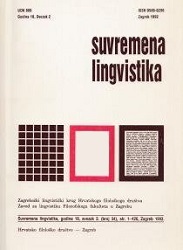Prinos proučavanju nizozemskih prezimena na primjeru prezimena motiviranih apelativom GRAAF
A contribution to the study of Dutch surnames on the example of surnames motivated by the appellative GRAAF
Author(s): Željana Pancirov Cornelisse, Maarten RomboutsSubject(s): Phonetics / Phonology, Morphology, Sociolinguistics
Published by: Hrvatsko filološko društvo
Keywords: surnames; anthroponomastics; the appellative GRAAF; Dutch language; the Netherlands; Flanders;
Summary/Abstract: This paper deals with the analysis of surnames motivated by the appellative graaf (i.e. count). Such surnames are derived from nobility titles in the Netherlands and Flanders and are the most common Dutch surnames. The case study is preceded by a brief overview of the historical, sociocultural and orthographic context within the Dutch language area to explain why Dutch surnames motivated by the same appellative are spelled differently in the Netherlands and Flanders. The first part of the article gives a review of the position of onomastics in Dutch Studies, the historical overview of Dutch surnames from the Netherlands and Flanders, with special emphasis on the changes before and after the introduction of the official spelling system of the Dutch language in 1804, and also on motivational classification of Dutch surnames. For the purposes of this case study, we first performed a quantitative analysis. We compiled a list to see how many holders of surnames motivated by the appellative graaf there are. We then divided the list into categories according to variations in the surnames. For the number of surnames in Flanders, we used the statistics from Statbel, the Belgian statistical office, and for the surnames in the Netherlands, the statistics from the database of the onomastic network Netwerk Naamkunde. The next step in the study was to search for the various forms of surnames containing the appellative graaf. The results of the search are shown in the pertaining table. A review of the lists reveals three variants in the forms of surnames (in terms of spelling, morphosyntax and phonology). These are analysed further in the text. Two online databases were used to determine the prevalence of the variants: FamilienamenBank for the Netherlands and Familienaam for Belgium. We then outlined the distribution of the most common variants of the surname graaf on the maps of the Netherlands and Belgium. In the Netherlands, the surname De Graaf has the highest concentration in the historic county of Holland, and in Belgium (Flanders), in the area bordering the Netherlands. Also, the distribution of the surnames Degraeve, De Graeve and Degrave (in Belgium) is shown. The results indicate somewhat limited mobility and decentralization. In the final part of the analysis, we looked at the origin of the surname graaf with respect to the motivational classification of Dutch surnames (see Brower 2000c), which divided the surnames into four categories: those derived from personal names, one’s origins, those motivated by occupation and those derived from nicknames. Almost all of the four categories occur in various spelling variants of surnames with the appellative graaf. The contribution of this paper is that surnames motivated by the appellative graaf are analyzed for the first time. Additionally, this is the first anthroponomastic article in Croatian on surnames from the Dutch language area. It will also enable Croatian anthroponomastics to get acquainted with the Dutch anthroponomasticon in detail.
Journal: Suvremena lingvistika
- Issue Year: 48/2022
- Issue No: 94
- Page Range: 167-190
- Page Count: 24
- Language: Croatian

